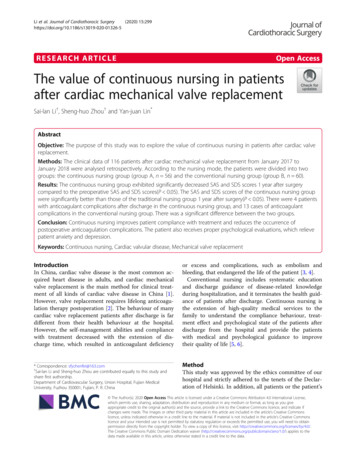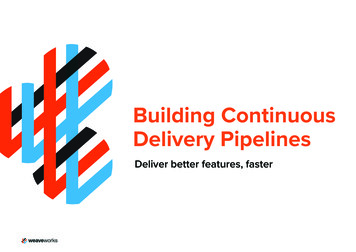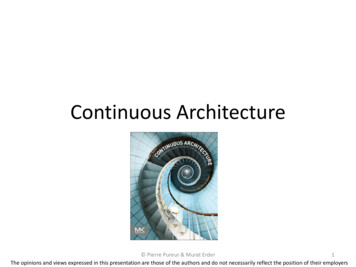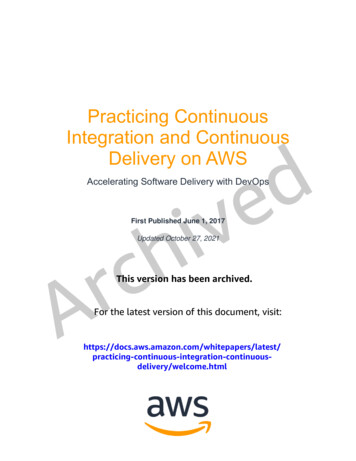
Transcription
Li et al. Journal of Cardiothoracic Surgery(2020) SEARCH ARTICLEOpen AccessThe value of continuous nursing in patientsafter cardiac mechanical valve replacementSai-lan Li†, Sheng-huo Zhou† and Yan-juan Lin*AbstractObjective: The purpose of this study was to explore the value of continuous nursing in patients after cardiac valvereplacement.Methods: The clinical data of 116 patients after cardiac mechanical valve replacement from January 2017 toJanuary 2018 were analysed retrospectively. According to the nursing mode, the patients were divided into twogroups: the continuous nursing group (group A, n 56) and the conventional nursing group (group B, n 60).Results: The continuous nursing group exhibited significantly decreased SAS and SDS scores 1 year after surgerycompared to the preoperative SAS and SDS scores(P 0.05). The SAS and SDS scores of the continuous nursing groupwere significantly better than those of the traditional nursing group 1 year after surgery(P 0.05). There were 4 patientswith anticoagulant complications after discharge in the continuous nursing group, and 13 cases of anticoagulantcomplications in the conventional nursing group. There was a significant difference between the two groups.Conclusion: Continuous nursing improves patient compliance with treatment and reduces the occurrence ofpostoperative anticoagulation complications. The patient also receives proper psychological evaluations, which relievepatient anxiety and depression.Keywords: Continuous nursing, Cardiac valvular disease, Mechanical valve replacementIntroductionIn China, cardiac valve disease is the most common acquired heart disease in adults, and cardiac mechanicalvalve replacement is the main method for clinical treatment of all kinds of cardiac valve disease in China [1].However, valve replacement requires lifelong anticoagulation therapy postoperation [2]. The behaviour of manycardiac valve replacement patients after discharge is fardifferent from their health behaviour at the hospital.However, the self-management abilities and compliancewith treatment decreased with the extension of discharge time, which resulted in anticoagulant deficiencyor excess and complications, such as embolism andbleeding, that endangered the life of the patient [3, 4].Conventional nursing includes systematic educationand discharge guidance of disease-related knowledgeduring hospitalization, and it terminates the health guidance of patients after discharge. Continuous nursing isthe extension of high-quality medical services to thefamily to understand the compliance behaviour, treatment effect and psychological state of the patients afterdischarge from the hospital and provide the patientswith medical and psychological guidance to improvetheir quality of life [5, 6].* Correspondence: sfychenfei@163.com†Sai-lan Li and Sheng-huo Zhou are contributed equally to this study andshare first authorship.Department of Cardiovascular Surgery, Union Hospital, Fujian MedicalUniversity, Fuzhou 350001, Fujian, P. R. ChinaMethodThis study was approved by the ethics committee of ourhospital and strictly adhered to the tenets of the Declaration of Helsinki. In addition, all patients or the patient’s The Author(s). 2020 Open Access This article is licensed under a Creative Commons Attribution 4.0 International License,which permits use, sharing, adaptation, distribution and reproduction in any medium or format, as long as you giveappropriate credit to the original author(s) and the source, provide a link to the Creative Commons licence, and indicate ifchanges were made. The images or other third party material in this article are included in the article's Creative Commonslicence, unless indicated otherwise in a credit line to the material. If material is not included in the article's Creative Commonslicence and your intended use is not permitted by statutory regulation or exceeds the permitted use, you will need to obtainpermission directly from the copyright holder. To view a copy of this licence, visit http://creativecommons.org/licenses/by/4.0/.The Creative Commons Public Domain Dedication waiver ) applies to thedata made available in this article, unless otherwise stated in a credit line to the data.
Li et al. Journal of Cardiothoracic Surgery(2020) 15:299Page 2 of 5relatives signed an informed consent form before thestudy.PatientsThe clinical data of 116 patients after cardiac mechanicalvalve replacement from January 2017 to January 2018were analysed retrospectively. According to the nursingmode, the patients were divided into two groups: thecontinuous nursing group (group A, n 56) and theconventional nursing group (group B, n 60). All patients completed the Self-Rating Depression Scale (SDS)and Self-Rating Anxiety Scale (SAS) at admission and 1year after surgery. All the patients’ general clinical dataare shown in Table 1. There were no statistically significant differences between the two groups, which indicatesthat the two groups were homogeneous and comparable.All of the patients also exhibited independent readingand comprehension abilities.Patients met the inclusion criteria if they underwentcardiac mechanical valve replacement. The following exclusion criteria were used: 1) lack of independent reading ability, 2) lack of communication equipment andinconvenient information communication, 3) postoperative death, or 4) refusal of continuing nursing servicesand participation in the study.Nursing methodsConventional nursingContinuing nursingOn the basis of traditional nursing, continuous nursingissued contact cards at discharge. The contents of thecontact card included basic patient information and thetelephone number and WeChat of the attending doctor,attending nurse and head of the department. The nurseinstructed the patient to join the WeChat group andinstructed the patient on the use of the WeChat functioncorrectly and skilfully after surgery. A medical staffmember in the group was reminded daily at 19:00 tosupervise the patients in the group to take anticoagulantdrugs, undergo regular outpatient re-examination, andguide the interactive communication, discussion, consultation and question-answer sessions within theWeChat group. At the same time, psychological counselling and psychological support were carried out for patients in need.Adjustment of warfarin doseRoutine medical services were provided to patients during hospitalization. The attending physician explaineddisease-related knowledge and surgical procedures toTable 1 Comparison of patients’ general data between the twogroupsItempatients and their families. Nursing staff provided dietknowledge, preoperative preparation, postoperative attention, methods, matters requiring anticoagulant drugsafter discharge, regular reviews of prothrombin time(PT) or the international normalized ratio (INR) andother health guidance. For patients with severe emotional disorders, we ask a special psychologist to do psychological intervention.Group AGroup BP valueNumber5660Age (year)49.6 8.553.2 9.50.785Male/Female24/3226/340.9590.745New York classification of cardiac functionI-II3839III1821Mitral valve2528Aortic valve1917Tricuspid valve11Aortic valve and mitral valve1114Cardiac valve0.918Research toolsSDSRecord of formal schoolingJunior high school and below3642senior middle school1615Universities and above43Place of residence: urban / rural17/3916/44The INR was checked once a week at the 1–2 monthsafter the patient was discharged. The INR was checkedonce every two weeks at the 3–4 months after the patient was discharged. The INR was checked once everythree weeks at the 5–6 months after the patient was discharged. The INR was checked once a month at the 7–12 months after the patient was discharged. The INRwas checked once every three month after the patientwas discharged 1 year. When the INR is greater than 1.7and less than 2.3, the dosage of warfarin remains unchanged. When the INR is less than 1.7, the dosage ofwarfarin increases by 0.625 mg. When the INR is greaterthan 2.3, the dosage of warfarin decreases by 0.625 mg.If the INR is greater than 3, stop taking warfarin on thesame day and ask the doctor to inject 20 mg of VitK1.On the second day, the dosage of warfarin decreases by0.625 mg.0.7790.660Zung’s SDS [7] was applied. This scale consists of 20items, including 10 negative symptoms and 10 positivesymptoms. Each question represents a feature of depression. All items together reflect the mood, body discomfort symptoms, spiritual movement, behaviour, andpsychological symptoms of patients with depression. The
Li et al. Journal of Cardiothoracic Surgery(2020) 15:299score involves 4 grades. The scores were obtained usingthe scoring method in ascending order (1 to 4) based onthe occurrence frequency of positive symptoms. Therough scores were obtained using the reverse scoringmethod in descending order (4 to 1) based on the occurrence frequency of negative symptoms. The standardscore was obtained by multiplying the scores by 1.25 androunding off the result. Normally, the upper limit score is41, and the standard total score is 53. A higher score indicates a more significant depression tendency.SASZung’s SAS [8] was applied. This scale mainly evaluatesthe subjective feeling of anxiety of the patients, and it isa self-evaluation tool. The SAS is extensively applied inclinics and is characterized by high reliability and validity. Fifteen items are stated with negative words. Thescores were obtained using the scoring method in ascending order (1 to 4) based on the occurrence frequency of symptoms. Five items [9, 10] are stated withpositive words. The scores were obtained using the reverse scoring method in descending order (4 to 1) basedon the occurrence frequency of symptoms. The totalscore was obtained by adding the scores of all items.The standard score was obtained by multiplying the totalscore by 1.25 and rounding off the result. The meanvalue of the standard score is 50. Grade description: 50means normal, 50 to 59 means mild anxiety, 60 to 69means medium anxiety, and 70 means severe anxiety.Statistical analysisTheorem information is expressed as the means standarddeviation. Independent-samples t-test was adopted for intergroup comparisons. The case number and constituentratio are used to express the qualitative data. Intergroupcomparisons of disordered categorical data were conducted using chi-square tests and Fisher’s exact probability tests. Intergroup comparisons of ordered data wereperformed using the Wilcoxon rank sum test. P 0.05 indicated that the difference was statistically significant.ResultsThere were no significant differences in SAS and SDSscores between the two groups before surgery. The SASand SDS scores of the continuous nursing group weresignificantly decreased 1 year after surgery compared tothe preoperative SAS and SDS scores, and the differences were statistically significant. However, the SASand SDS scores of the conventional nursing group werealso lower 1 year after surgery than the scores beforesurgery, but these differences were not statistically significant. The SAS and SDS scores of the continuousnursing group were significantly better 1 year afterPage 3 of 5surgery than those of the traditional nursing group, andthese differences were statistically significant (Table 2).All patients were followed up for 1 year. There were 4patients with anticoagulant complications after dischargein the continuous nursing group, including 3 cases ofbleeding and 1 cases of embolism, and 13 cases of anticoagulant complications in the conventional nursinggroup, including 10 cases of bleeding and 3 cases of embolism. There was a significant difference between thetwo groups (P 0.027).DiscussionContinuous nursing extends treatment and rehabilitationcare during hospitalization to the family after dischargeto help improve the self-management of patients and ensure that information, treatment and nursing servicescontinue without sudden interruption. Continuous nursing is a new nursing service model that occurred withthe development of society and changes in medical services [11, 12]. In China, the current medical services aremainly focused on hospitals, and the relationship between doctors and patients ends when the patients leavethe hospital [13].Mechanical valve replacement is an effective methodfor the treatment of cardiac valve diseases, and it greatlyimproves the cardiac function of patients and saves theirlives. Most patients who undergo valve replacement inChina are middle-aged people. These patients choose amechanical valve, and they must be treated with lifelonganticoagulant therapy after surgery. Warfarin is the mainanticoagulant in China. Therefore, these patients mustregularly monitor the INR or PT after surgery and constantly adjust the dose of anticoagulant to prevent bleeding, embolism and other complications of improperanticoagulant treatment. Most of the mechanical valvereplacement patients in China are from rural areas, andtheir academic qualifications are generally low. The lackof disease-related knowledge, poor self-managementability, and the lack of awareness of the importance ofanticoagulant therapy result in an inability to take anticoagulant drugs correctly after discharge, which easilycauses insufficient or excessive anticoagulant andTable 2 Comparison of psychological state before and afternursing interventionItemGroup AGroup BP valuePreoperation44.8 10.645.3 12.70.8971 year after operation33.8 9.2*44.1 11.30.022The SDS scoreThe SAS scorePreoperation51.3 13.253.2 14.50.9121 year after operation40.2 10.6*50.5 12.40.018The “*” indicate that compared with preoperation the P 0.05
Li et al. Journal of Cardiothoracic Surgery(2020) 15:299complications, such as embolism and bleeding [14, 15].Therefore, we should strengthen the management of patients after valve replacement after discharge, inculcatehealth education knowledge into patients without interruption and give patients correct guidance and help toavoid the disconnect of the patients from hospitals tothe family to solve the problem of insufficient supportafter discharge. Many studies have shown that continuous nursing can improve patients’ compliance after discharge and reduce complications. Chi S et al. [16]conducted a prospective study to explore the impact ofcontinuous nursing intervention on the rehabilitation ofdiabetic patients. The results showed that continuousnursing can improve patients’ self-care ability, and reduce the occurrence of complications. Yu YL et al. [17]conducted a randomized controlled study, and the report showed that continuation care can help patientswith chronic obstructive pulmonary disease to improvetheir compliance with oxygen therapy and self-care ability. The study of Li P et al. [18] shown that continuouscare can improve the self-efficacy of chronic obstructivepulmonary disease patients and reduce complications.Our study has reached the same conclusion. In the continuous nursing group, we remind patients to review theINR as planned and help them adjust the warfarin dosein time through WeChat. However, many patients in theconvention nursing group forget to review the INR regularly, especially for patients with poor compliance. It isalso more inconvenient for them to ask doctors to adjustthe dosage of warfarin. Therefore, there are fewer complications related to anticoagulation in the continuousnursing group.Cardiac valve replacement has a relatively high risk ofsurgical complications compared to other surgeries, andthe patient does not possess relevant knowledge of theoperation. Therefore, fear and tension are inevitable before and after surgery. Cardiac mechanical valve replacement requires lifelong anticoagulant therapy. For mostpatients, there will be a heavy psychological burden.Some patients lose confidence, and the negative feelingsare obvious. The main causes of anxiety should be evaluated during the diagnosis and treatment process and intervened in a timely manner. If negative emotions arecaused by long-term disease remission, the main purpose of the intervention is to improve the main symptoms and comfort patients. If a patient’s anxiety iscaused by a lack of understanding of the disease anddoubts about the efficacy of the treatment, doctors andnurses should communicate with the patient as soon aspossible and explain the process and effect of cardiacvalve replacement. If necessary, other similar patientsmay be invited to share their personal experiences to enhance their confidence. If a patient is worried abouttheir lack of drug and nursing knowledge after discharge,Page 4 of 5the continuous nursing model with improved WeChat,telephone and other follow-up methods to provide professional service and psychological support to patientsafter discharge may solve this problem. The services ofcontinuous nursing provide not only professional knowledge and support for the treatment of symptoms butalso psychological support to promote the physical andmental recovery of patients [19]. Psychological supportis helpful to enhance the patient’s subjective initiativeand self-control ability, to meet the safety and comfortneeds of patients with special conditions, to alleviate thepatient’s undefined negative psychology, to eliminate thepatient’s undefined worries, to help patients maintainthe best physical and mental state and to improve thepatient’s undefined psychological adaptability and qualityof life [20]. This study provided a series of continuousnursing services for patients after mechanical heart valvereplacement to understand the patients’ needs, difficulties and psychological feelings in a timely manner and toprovide effective communication and guidance to solveproblems and effectively alleviate the symptoms of depression and anxiety in patients.There are several limitations in this study. First, thisstudy was a retrospective study with a small sample size,and patients who did not have independent reading ability, communication equipment or convenient information communication were not included in this study,which may cause selection bias. Second, this study was asingle-centre study, and more research from multiplecenters is mandatory to assess the value of continuousnursing in the future. Third, the follow-up period of thisstudy was brief, and a longer term follow-up period isneeded. Fourth, during the follow-up period, the coagulation function re-examination was performed in thelocal hospital, and the INR measurement method maybe different in different hospitals.ConclusionContinuous nursing extends high-quality hospital nursing service and psychological support to the patient’sfamily, which improved patient compliance with treatment, reduced the occurrence of postoperative anticoagulation complications, and provided the patient withproper psychological evaluation to relieve anxiety anddepression.AbbreviationsSDS: Self-Rating Depression Scale; SAS: Self-Rating Anxiety Scale;PT: Prothrombin Time; INR: International Normalized RatioAcknowledgementsWe highly acknowledge the contribution by all the doctors and nurses inour department.
Li et al. Journal of Cardiothoracic Surgery(2020) 15:299Authors’ contributionsY-J L,S-L L and S-H Z designed the study, collected theclinical data, performed the statistical analysis and drafted the manuscript. The authors readand approved the final manuscript.FundingThis research was sponsored by Joint Finds for the innovation of science andTechnology, Fujian province (Grant number:2017Y9052).Availability of data and materialsThe datasets used and analysed during the current study are available fromthe corresponding author on reasonable request.Ethics approval and consent to participateThis study was approved by the ethics committee of our hospital and strictlyadhered to the tenets of the Declaration of Helsinki. In addition, all patientsor the patient’s relatives signed an informed consent form before the study.Consent for publicationAll the authors agree to the publication of this manuscript.Competing interestsThe authors declare that they have no competing interests.Received: 3 June 2020 Accepted: 21 September 2020References1. Hendriks JMI, Wit R, Elins HJGM, et al. Nurse-led carevs.usual care forpatients with atrial fibrillation:results of arandomized trial of integratedchronic care VS.routine clinical-care in ambulatory patients with atrialfibrillation. Eur Heart J. 2012;33(21):2692–9.2. Xing BB, Cai JJ, Shen H, et al. Progress in rehabilitation and nursing care ofpatients undergoing cardiac valve replacement. Nurs Pract Res. 2015;12(6):33–5.3. Xu DN, Dai XO. Effect of continuous nursing on quality of life of patientsafter cardiac valve replacement. Contemp Nurse. 2017;4(1):38–40.4. Astin F, Carroll DL. Education for nurses working in cardiovascular care: aEuropean survey. Eur J Cardiovasc Nurs. 2014;13(6):532–40.5. Griffin KM. Evolution of transitional care settings:past,present,future. AACNClin Issues. 1998;9(3):398–408.6. Brooten D, Naylor MD, York R, et al. Lessons learnedfrom testing the qualitycost model of advanced practice nursing (APN) transitional care. J NursScholarsh. 2002;34(4):369–75.7. Zung WW. A self-rating depression scale. Arch Gen Psychiatry. 1965;12(1):63–70.8. Zung WW. A rating instrument for anxieties orders. Psychosomatics. 1971;12(6):371–9.9. Johansson K, Nuutila L, Virtanen H, et al. Preoperative education fororthopaedic patients: systematic review. J Adv Nurs. 2005;50(2):212–3.10. Zhang LH, Wang YR. Influence of continuous nursing support onpsychological states and coping styles of patients experiencing radicalmastectomy. Int J Nurs. 2013;32(10):2251–2.11. Yan X, Shang J, Lian T, et al. GW25-e4570 Effect of Continuous NursingIntervention on Quality of Life in Elderly Patients with Chronic Diseases. JAm Coll Cardiol. 2014;64(16):C222.12. Carroll A, Dowling M. Discharge planning communication education andpatient participation. Br J Nurs. 2007;16(14):882–6.13. Liang JJ, Yang B, Wu S. Follow-up study of life quality of old patients aftercardiac pace maker implantation. Chinese J Cardiovas Rehab Med. 2011;20(3):196–8.14. Dong L, Shi YK, Tian ZP, et al. Intracranial hemorrhage in anticoagulationafter cardiac mechanical valve replacement. Chinese J Thoracic CardiovascSurg. 2003;19(4):206–8.15. Liu Y, Meng X, Chen BT. Observation on low anticoagulant therapy ofartificial mechanical valve. Chinese J Thoracic Cardiovasc Surg. 2001;5(17):263–5.16. Chi S, Liu JL, Kang HC, Lv DM. Continuous nursing intervention on recoveryof diabetic patients. J Biol Regul Homeost Agents. 2018;32(6):1507–13.17. Yu YL, Zheng XS, Han XX, Sun MJ. The application value of continuousnursing for home oxygen therapy of patients in the stable phase of chronicPage 5 of 5obstructive pulmonary disease. Eur Rev Med Pharmacol Sci. 2017;21(3Suppl):67–72.18. Li P, Gong Y, Zeng G, Ruan L, Li G. A new mode of community continuingcare service for COPD patients in China: participation of respiratory nursespecialists. Int J Clin Exp Med. 2015;8(9):15878–88.19. Hew KF, Hara N. An online listserv for nurse practitioners: a viable venue forcontinuous nursing professional development? Nurs Educ Today. 2008;28(4):450–7.20. Zhou J, Yang MQ, Yu XW, et al. Patients’depression and anxiety andintervention after pacemaker implantation. J Clin Res. 2007;24(7):1057–9.Publisher’s NoteSpringer Nature remains neutral with regard to jurisdictional claims inpublished maps and institutional affiliations.
valve replacement is the main method for clinical treat-ment of all kinds of cardiac valve disease in China [1]. However, valve replacement requires lifelong anticoagu-lation therapy postoperation [2]. The behaviour of many cardiac valve replacement patients after discharge is far different from their health behaviour at the hospital.











